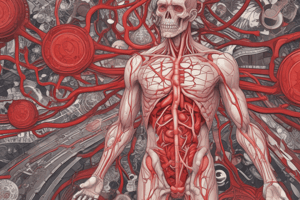Podcast
Questions and Answers
What temperature defines hypothermia?
What temperature defines hypothermia?
Anything less than 36*C
The four routes of heat loss, in order from greatest to least, are __________.
The four routes of heat loss, in order from greatest to least, are __________.
Radiation, Convection, Conduction, Evaporation
What nerve fibers mediate the sweat response?
What nerve fibers mediate the sweat response?
Cholinergic sympathetic fibers
Does regional anesthesia affect the thermoregulatory mechanism?
Does regional anesthesia affect the thermoregulatory mechanism?
Name 5 drugs that have been used to prevent shivering.
Name 5 drugs that have been used to prevent shivering.
Explain radiant heat loss.
Explain radiant heat loss.
How does radiant heat loss occur?
How does radiant heat loss occur?
What is evaporative heat loss?
What is evaporative heat loss?
How does evaporative heat loss occur?
How does evaporative heat loss occur?
What is conductive heat loss?
What is conductive heat loss?
What is convective heat loss?
What is convective heat loss?
How do convective and conductive heat loss occur?
How do convective and conductive heat loss occur?
What type of heat loss accounts for most of the heat lost during surgery?
What type of heat loss accounts for most of the heat lost during surgery?
What temperature defines hyperthermia?
What temperature defines hyperthermia?
What is the primary means a newborn infant has to increase body temperature?
What is the primary means a newborn infant has to increase body temperature?
Flashcards are hidden until you start studying
Study Notes
Hypothermia and Hyperthermia
- Hypothermia is defined as a body temperature less than 36°C.
- Hyperthermia occurs when body temperature exceeds 38°C.
Routes of Heat Loss
- The four routes of heat loss ranked from greatest to least are:
- Radiation
- Convection
- Conduction
- Evaporation
Nervous System and Thermoregulation
- Cholinergic sympathetic fibers mediate the sweat response.
- Neuraxial anesthesia significantly lowers thresholds for shivering and vasoconstriction by over half a degree Celsius, potentially leading to hypothermia without patient awareness.
Drugs for Preventing Shivering
- Five drugs used to prevent shivering include:
- Demerol
- Clonidine
- Ketanserin
- Magnesium sulfate
- Dexmedetomidine
Radiant Heat Loss
- Radiant heat loss is the transfer of electromagnetic radiation from the body to the cooler environment, primarily through infrared radiation.
- This occurs most significantly in the head due to its high blood flow.
Evaporative Heat Loss
- Evaporative heat loss involves moisture from the skin, organs, and respiratory tract transitioning from liquid to gas, requiring energy and resulting in heat loss from the body.
Conductive Heat Loss
- Conductive heat loss is the transfer of heat through physical contact; it occurs when a patient lies on a cold operating table, losing heat to this colder surface.
Convective Heat Loss
- Convective heat loss occurs through air currents generated by emitted heat; warm air rises and is replaced by cooler air.
Significance of Heat Loss During Surgery
- Radiant heat loss is the predominant form of heat loss in surgical patients, contributing significantly to overall heat loss.
Thermogenic Response in Newborns
- Newborns respond to a 2°C temperature drop by releasing norepinephrine, triggering lipolysis of brown adipose tissue for heat production, a process known as nonshivering thermogenesis. This increases metabolism, producing heat and ketones while raising oxygen consumption.
Studying That Suits You
Use AI to generate personalized quizzes and flashcards to suit your learning preferences.





